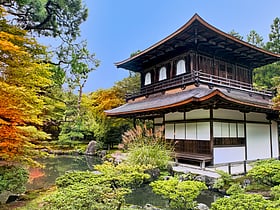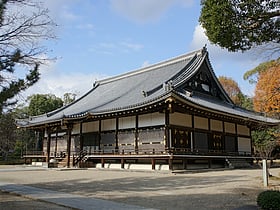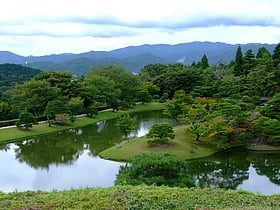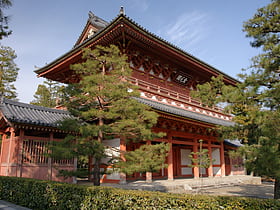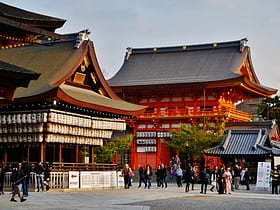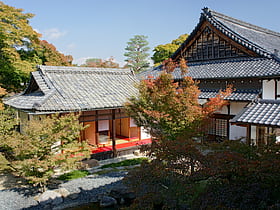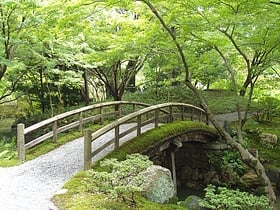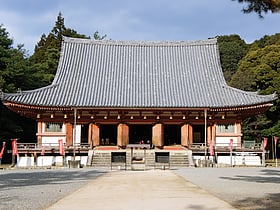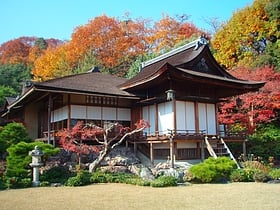Kyoto: Historical Place
Places and attractions in the Historical place category
Categories
- Temple
- Sacred and religious sites
- Buddhist architecture
- Buddhist temple
- Museum
- Historical place
- Park
- Unesco
- Garden
- Art museum
- Specialty museum
- Street
- Universities and schools
- History museum
- Palace
- Area
- Theater
- Concerts and shows
- Shopping
- Bridge
- Neighbourhood
- Sport venue
- Sport
Ginkaku-ji
Enduring Zen temple with scenic gardens Ginkaku-ji, also known as the Silver Pavilion, is a historic temple that graces the cultural tapestry of Kyoto, Japan. This Zen temple, formally named Jishō-ji, was constructed in 1482 as a retirement villa for the shogun Ashikaga Yoshimasa, who intended to cover the...
Ninna-ji
Buddhist temple with scenic grounds Ninna-ji is a historic temple that stands as a beacon of cultural heritage in the ancient city of Kyoto, Japan. This revered site, founded in the year 888, is a quintessential representation of Japanese religious architecture and traditional aesthetics.
Shugakuin Imperial Villa
Nestled in the serene landscapes of Kyoto, Japan, the Shugakuin Imperial Villa is a hidden gem that embodies the tranquil beauty and traditional aesthetics of Japanese garden design. This imperial park, established in the 17th century by Emperor Gomizuno-o, is a...
Daitoku-ji
Buddhist temple site known for gardens Nestled in the northern part of Kyoto, Daitoku-ji stands as a testament to the city's deep-rooted Zen Buddhist traditions. This sprawling temple complex, established in the 14th century, is not only a place of religious significance but also a serene park that offers a...
Yasaka Shrine
Yasaka Shrine, nestled in the heart of Kyoto, is a beacon of tradition and an enduring testament to Japan's spiritual heritage. This historic Shinto shrine, also known as Gion Shrine, is renowned for its stunning architecture and its pivotal role in the city's cultural...
Tōfuku-ji
Scenic 13th-century Buddhist temple Tōfuku-ji, a Zen Buddhist temple, stands as a beacon of tranquility and historical significance in the culturally-rich city of Kyoto, Japan. Founded in 1236 during the Kamakura period, this temple is particularly renowned for its spectacular autumn foliage and the...
Tenryū-ji
Zen temple in a scenic, tranquil setting Tenryū-ji is a serene oasis nestled in the heart of Arashiyama, a scenic district on the western outskirts of Kyoto, Japan. Founded in 1339 by the shogun Ashikaga Takauji, this historic temple serves as the head temple of the Tenryū branch of Rinzai Zen Buddhism.
Sanjūsangen-dō
Sanjūsangen-dō, a revered temple situated in the heart of Kyoto, Japan, is a testament to the city's rich cultural and spiritual history. Established in 1164 and rebuilt in the 13th century after a fire, this temple is renowned for its impressive collection of...
Sentō Imperial Palace
Picturesque 17th-century palace gardens Sentō Imperial Palace, nestled in the heart of Kyoto, Japan, stands as a serene testament to the city's rich imperial past. This historic site, once a residence for retired emperors, embodies the opulent and refined aesthetics of Japanese court life.
Daigo-ji
Buddhist temple with gardens and a museum Daigo-ji, an ancient temple of profound historical significance, stands as a testament to the rich cultural heritage of Kyoto, Japan. Founded in the early Heian period, in 874, Daigo-ji is not merely a temple but an extensive complex that includes a pagoda, several...
Eikan-dō Zenrin-ji
Prominent Buddhist temple complex Eikan-dō Zenrin-ji, nestled amidst the vibrant hues of Kyoto's Higashiyama district, stands as a serene testament to the city's rich cultural and spiritual heritage. This historic temple, dating back to the Heian period, is a cornerstone of Japanese Pure Land Buddhism...
Daikaku-ji Temple
Buddhist temple with traditional gardens Daikaku-ji Temple is an emblem of serenity nestled in the ancient city of Kyoto, Japan. Established in the early Heian period, the temple originally served as a residence for Emperor Saga and was later converted into a Buddhist temple.
Kitano Tenmangū
Shrine and garden with annual festival Kitano Tenmangū is a historic Shinto shrine nestled in the cultural heart of Kyoto, Japan. Renowned for its profound connection to scholarship and the arts, this revered site is dedicated to Sugawara no Michizane, a scholar, poet, and politician deified as Tenjin, the...
Seimei Shrine
Seimei Shrine, a serene and historically rich Shinto shrine nestled in the heart of Kyoto, Japan, stands as a tribute to the revered Heian-era astrologer and diviner, Abe no Seimei. This tranquil site, enveloped by lush greenery, offers a glimpse into Japan's ancient...
Shōren-in
Shōren-in, a serene oasis nestled in the bustling city of Kyoto, Japan, is a historic temple that offers a tranquil retreat from the urban pace. Known for its intimate connection with the imperial family and its role as a residence for high-ranking monks, Shōren-in...
Ōkōchi Sansō
Ōkōchi Sansō is the former home and garden of the Japanese jidaigeki actor Denjirō Ōkōchi in Arashiyama, Kyoto. The villa is open to the public for an admission fee and is known for its gardens and views of the Kyoto area. Several of the buildings are recorded as cultural properties by the national government.
Chion-in
Grand circa-1618 Buddhist temple complex Chion-in in Higashiyama-ku, Kyoto, Japan is the headquarters of the Jōdo-shū founded by Hōnen, who proclaimed that sentient beings are reborn in Amida Buddha's Western Paradise by reciting the nembutsu, Amida Buddha's name.
Hōnen-in
Hōnen-in is a Buddhist temple located in Sakyō-ku, Kyoto, western Japan. Honen-in is a single-estate temple located in Shikagaya, Sakyo-ku, Kyoto. It was originally part of the Jodo sect, but became independent and is now a single religious corporation. Its official name is Zenkisan Honen-in Manmukyoji Temple.
Hirano Shrine
Historic shrine with cherry blossoms The Hirano Shrine is a Shinto shrine in Kyoto. This shrine is known and popular for its gardens and many trees.
Kamigamo Shrine
Kamo Shrine is a general term for an important Shinto sanctuary complex on both banks of the Kamo River in northeast Kyoto. It is centered on two shrines.
Shinsenen
Shinsenen is a Shingon Japanese Buddhist temple located south of Nijō Castle in the approximate center of the modern city of Kyoto, Honshu, Japan. It was founded by Kūkai in 824 and predominantly consists of a large water garden centering about a pond. It is said to be the oldest existing garden in Kyoto.
Nonomiya Shrine
Storied Shinto shrine to marriage Nonomiya Shrine, or the Shrine in the Country, is a Shinto shrine in the Arashiyama district on the west side of the city of Kyoto in Kyoto prefecture, Japan, close to its bamboo forest.
Yasaka Kōshin-dō
Yasaka Kōshin-dō, or in its full name Daikoku-san Kongō-ji Kōshin-dō is a small temple located in Higashiyama, Kyoto, Japan. The temple can be found in the vicinity of Kiyomizu-dera.
Chishaku-in
Chishaku-in is a Buddhist temple in Higashiyama-ku, Kyoto, Japan. It is affiliated with Shingon-shū Chizan-ha Buddhism. It was established in 1601. The temple has a historic garden that was said to be a favourite of Sen no Rikyū.
Kōryū-ji
Kōryū-ji is a Shingon temple in Uzumasa, Ukyō Ward, Kyoto, Japan. The temple is also known by the names Uzumasa-dera and Kadono-dera, and was formerly known as Hatanokimi-dera, Hachioka-dera and Hōkō-ji.
Atago Shrine
Atago Shrine is a Shinto shrine on Mount Atago, the northwest of Kyoto, Japan. Enshrined is Atago Gongen who protects Kyoto from fire. Shugendō practices and a place for worship are known from the eighth century. The late-Kamakura period Honden has been designated an Important Cultural Property.
Hōsen-in
Hōsen-in is a Buddhist temple of the Tendai-shū, located in Sakyō-ku of Kyoto-shi, in the prefecture of Kyoto, Japan. It is specified as a natural monument by the Kyoto government.
Map

